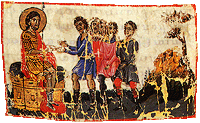 |
|
 |
The Hexabiblos
 onstantine Harmenopoulos was undoubtedly the most remarkable jurist of the Late Byzantine period. All we know about him is
onstantine Harmenopoulos was undoubtedly the most remarkable jurist of the Late Byzantine period. All we know about him is
 that he wrote the Procheiros Nomos or Hexabiblos in 1344-45 and that shortly afterwards he was appointed katholikos krites ("universal judge")
of Thessalonike (an office which corresponds nowadays to that of Chief Justice of the Court of Appeals). that he wrote the Procheiros Nomos or Hexabiblos in 1344-45 and that shortly afterwards he was appointed katholikos krites ("universal judge")
of Thessalonike (an office which corresponds nowadays to that of Chief Justice of the Court of Appeals).
The Hexabiblos was not original in content as a legal work, but rather a simple compilation of the existing legislation, accompanied by two prefaces by the author and comments. The contribution of Harmenopoulos was that he very assiduously assembled all the previous laws that he could discover in legal corpuses, even those most hard to find, and organised them thematically, so that they were easily accessible to the judges. This was something that happened for the first time in Byzantium and constituted the most important advantage of the book. Perhaps this was one of the reasons why it was translated into many languages and formed the basis of the civil law of the Greeks not only during the period of Turkish rule but also in the modern Greek state until the new Civil Code was put in force in 1946. Seventy-one manuscript copies of this book are preserved, dating from various periods between the 14th and the 18th centuries.
The Hexabiblos begins with two prefaces. The first contains advice to the judges: it tells them they should be unbiased and uninfluenced in the performance of their duty, that they should consider the real intent of the legislator and that they should not condemn any accused person without consulting with other experienced judges. In the second preface, Harmenopoulos presents a list of the
legal material
he used. The first book subsequently refers to the history of Roman law, to legal procedure and to social issues such as the legal status of women, slaves and soldiers. The second book contains regulations on economic issues (e.g. unjustifiable enrichment or the discovery of treasure) as well as on the construction of buildings (e.g. the position of chimneys or of the front door with respect to neighbouring buildings). Quite impressive is the detail by which the 'right of view' is regulated.
By this the leglislator meant the right of the Byzantine people, when a new building was erected, to protect their view towards the mountains, the sea, the gardens and the graphes (the mosaics and frescoes), without having to assume an unnatural position. Of the other books, the third deals with financial questions (purchases, sales, loans etc.), the fourth deals with marriage (rules concerning when it is permitted, or concerning dowry), and the fifth is devoted to wills and testaments. Finally, the sixth book refers to penal law and examines the sanctions on all criminal acts in turn. A general characteristic of these sanctions is that they were generally harder on the poor than on the rich, in the sense that the latter were in a position to buy off part of their penalty.
See also : Secular Courts
|